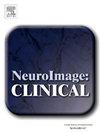Neurometabolic network (NMetNet) for functional neurological disorder in children and adolescents
IF 3.6
2区 医学
Q2 NEUROIMAGING
引用次数: 0
Abstract
Objectives
Functional neurological disorder (FND) in children and adolescents is a biopsychosocially complex condition characterized by a wide range of neurological symptoms. Using magnetic resonance spectroscopy to study neurometabolites has become an important approach to studying the mechanisms of FND. Unlike previous studies focusing on concentration-level analysis, this study examines conditional dependencies between six neurometabolites: N-acetyl aspartate, creatine, glutathione, choline, myo-inositol, and glutamate. Conditional dependence implies that two neurometabolites have joint variability that is not mediated by other neurometabolites.
Methods
A Bayesian graphical lasso approach was used to estimate neurometabolites’ conditional dependencies in three regions of interest: the anterior default mode network (aDMN), supplementary motor area (SMA), and posterior default mode network (pDMN). We introduce the term neurometabolic network (NMetNet) to describe these conditional dependencies.
Results
Children and adolescents with FND (vs. healthy controls) showed a loss of conditional dependencies related to creatine and glutathione between the aDMN and SMA/pDMN. Glutathione is the primary antioxidant in the brain. Creatine plays a key role in maintaining bioenergetics and also acts as an antioxidant.
Conclusions
These findings suggest that FND is characterized by dysregulated bioenergetics and increased vulnerability to oxidative stress. Understanding NMetNet in FND offers novel insights into the disorder’s neurobiology, with implications for therapeutic interventions to restore energy homeostasis and oxidative balance.
儿童和青少年功能性神经障碍的神经代谢网络(NMetNet)
目的:儿童和青少年的功能性神经障碍(FND)是一种以广泛的神经症状为特征的生物、心理和社会复杂疾病。利用磁共振波谱技术研究神经代谢物已成为研究FND机制的重要手段。与以往的研究侧重于浓度水平分析不同,本研究考察了六种神经代谢物之间的条件依赖性:n-乙酰天冬氨酸、肌酸、谷胱甘肽、胆碱、肌醇和谷氨酸。条件依赖性意味着两种神经代谢物具有不受其他神经代谢物介导的联合变异性。方法采用贝叶斯图形套索方法估计神经代谢物在三个感兴趣的区域的条件依赖性:前默认模式网络(aDMN)、辅助运动区(SMA)和后默认模式网络(pDMN)。我们引入术语神经代谢网络(NMetNet)来描述这些条件依赖性。结果与健康对照相比,患有FND的儿童和青少年在aDMN和SMA/pDMN之间表现出与肌酸和谷胱甘肽相关的条件依赖性丧失。谷胱甘肽是大脑中主要的抗氧化剂。肌酸在维持生物能量方面起着关键作用,同时也是一种抗氧化剂。结论FND具有生物能量失调和氧化应激易感性增加的特征。了解NMetNet在FND中的作用,为了解FND的神经生物学提供了新的见解,对恢复能量稳态和氧化平衡的治疗干预具有重要意义。
本文章由计算机程序翻译,如有差异,请以英文原文为准。
求助全文
约1分钟内获得全文
求助全文
来源期刊

Neuroimage-Clinical
NEUROIMAGING-
CiteScore
7.50
自引率
4.80%
发文量
368
审稿时长
52 days
期刊介绍:
NeuroImage: Clinical, a journal of diseases, disorders and syndromes involving the Nervous System, provides a vehicle for communicating important advances in the study of abnormal structure-function relationships of the human nervous system based on imaging.
The focus of NeuroImage: Clinical is on defining changes to the brain associated with primary neurologic and psychiatric diseases and disorders of the nervous system as well as behavioral syndromes and developmental conditions. The main criterion for judging papers is the extent of scientific advancement in the understanding of the pathophysiologic mechanisms of diseases and disorders, in identification of functional models that link clinical signs and symptoms with brain function and in the creation of image based tools applicable to a broad range of clinical needs including diagnosis, monitoring and tracking of illness, predicting therapeutic response and development of new treatments. Papers dealing with structure and function in animal models will also be considered if they reveal mechanisms that can be readily translated to human conditions.
 求助内容:
求助内容: 应助结果提醒方式:
应助结果提醒方式:


